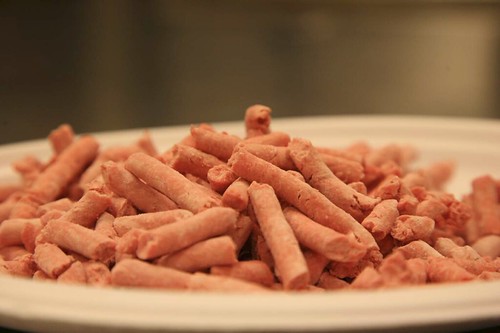It's hard to avoid; The media onslaught of the attack of the "Pink Slime". Apparently this somehow inedible part of the cow has been treated with poisonous ammonia and snuck into your food right under you very nose! But WAIT! Before you give up beef for good, let me help you with a few things.
God bless the people who created Pink Slime is a Myth website because they basically cover everything I was going to talk about today. So instead. I'll take my favorite article they wrote, copy and paste and encourage you to read on.
It's easy to get wrapped up in the media. There's a certain amount of trust we instill in our undercover reporters and investigators but unfortunately, they really dropped the ball of facts with this one and focused only on the slimy non-truth.
Top 7 Myths of “Pink Slime”
The media has been spreading a lot of myths about what “pink slime” is. The image spreading on the internet is actually mechanically separated chicken, not beef. Read more about the top 7 myths of pink slime below.
Boneless lean beef trimmings actually looks like this.

Once again, the beef industry is under attack but you can rest assured that we stand behind our product 100% and will continue to raise healthy nutritious beef. So, Eat up!
Myth 1:
Boneless lean beef trimmings look like pink slime.Fact:
The photo many media have used to represent pink slime is not boneless lean beef trimmings. It’s actually mechanically separated chicken.Boneless lean beef trimmings actually looks like this.

Myth 2:
“Boneless lean beef trimmings” or “lean finely textured beef” which have recently been called “pink slime,” are just “fillers” and not beef at all.Fact:
As their real names suggest, boneless lean beef trimmings are 100% USDA inspected beef. Imagine trimming fat from a roast or steak. There’s always some meat that is trimmed with the fat. It is this meat, trimmed from the fat, which becomes boneless lean beef trimmings. When you compare the nutrition analysis of this lean beef with 90% lean/10% fat ground beef, they are virtually identical. That’s because boneless lean beef trim is beef – period.Myth 3:
Ground beef produced with boneless lean beef trimmings is less nutritious than other ground beef.Fact:
A side-by-side comparison of nutrition labels for 90% lean/10% fat ground beef demonstrates this lean beef has substantially identical nutritional value as 90% lean ground beef. Lean ground beef is low in fat and is a good or excellent source of 10 essential nutrients, including protein, iron, zinc and B vitamins.Myth 4:
Boneless lean beef trimmings are produced from inedible meat.Fact:
Boneless lean beef trimmings are 100% edible meat. These trimmings are simply the lean beef removed from the meat and fat that is trimmed away when beef is cut into steaks and roasts. The meat in these trimming is nearly impossible to separate with a knife so, historically, this product only could be used in cooked beef products when the fat was cooked and separated for tallow. But now there is a process that separates the fat from the fresh lean beef, and it is this fresh lean beef that can be used in ground meat foods like hamburger and sausages. No process exists that could somehow make an inedible meat edible.Myth 5:
Dangerous chemicals are added to boneless lean beef trimmings.Fact:
This is a reference to ammonium hydroxide, essentially ammonia and water, both naturally occurring compounds that have been used to make foods safe since 1974, when the Food and Drug Administration declared it GRAS or Generally Recognized as Safe, the highest safety attribution the agency assigns to compounds. Boneless lean beef trimmings receive a puff of ammonium hydroxide to eliminate bacteria safely and effectively. Ammonium hydroxide is a naturally occurring compound found in many foods, in our own bodies and the environment. Food safety experts and scientists agree it is an effective way to ensure safer ground beef.Myth 6:
Food safety advocates are concerned about the safety of boneless lean beef trimmings.Fact:
Scientists, advocates and plaintiff’s lawyers, who in many cases are critical of the beef industry, have all stepped forward to praise Beef Products Inc. and its efforts at food safety.Myth 7:
Because ammonium hydroxide is an ingredient, ground beef containing boneless lean beef trimmings should be labeled.Fact:
Ammonium hydroxide is not an ingredient added to the product – rather, the product receives a puff of ammonium hydroxide gas to eliminate bacteria safely and effectively. Ammonia /ammonium hydroxide is naturally occurring and used in processing many foods today, including baked goods, cheese, chocolate, and puddings. It is used in the production of each of these foods as a processing aid and not an ingredient, so not “on the label” of those foods either. It is safe and has been approved by FDA since 1974 and specifically approved for its food safety benefits in beef processing since 2001Once again, the beef industry is under attack but you can rest assured that we stand behind our product 100% and will continue to raise healthy nutritious beef. So, Eat up!

No comments:
Post a Comment